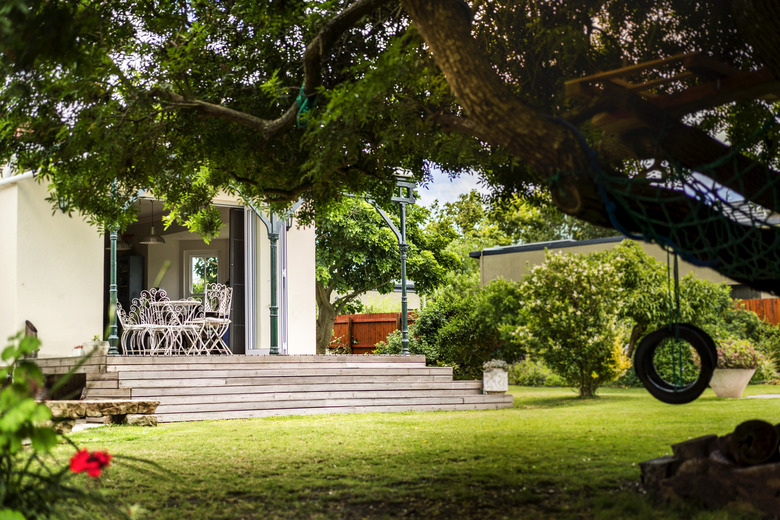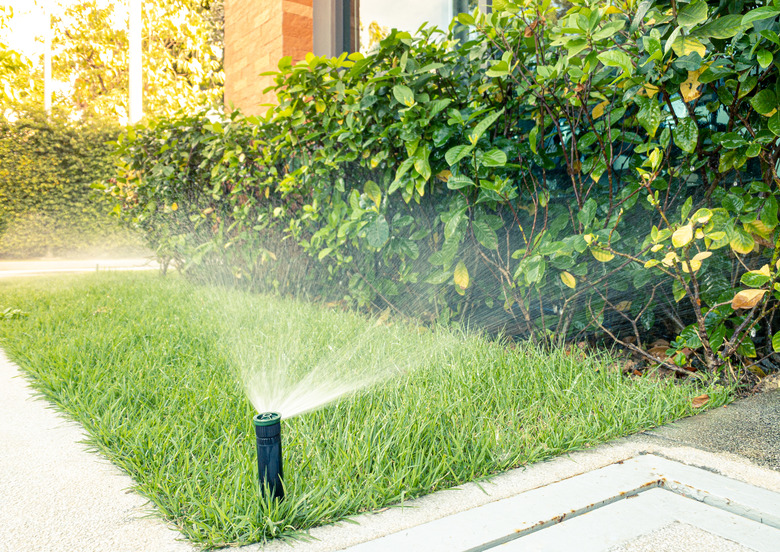What Is Defensible Space? What You Need To Know About This Wildfire Safety Method
We may receive a commission on purchases made from links.
As wildfires become more frequent and more severe in many parts of North America, defensible space has become a hot topic (no pun intended). This is especially true in the most fire-prone areas (such as California's State Responsibility Areas), where homeowners may be required to conform to fire-safe building practices, use fire-safe materials and create defensible space around their homes.
While some state and local governments may offer financial incentives or assistance for creating a defensible space, the onus of creating a defensible space zone around the house falls on every homeowner who lives in a wildfire zone, and the stakes couldn't be higher. In California alone, the year 2020 saw a record-setting 52,113 fires that burned almost 9 million acres, damaging 10,488 structures and killing 31 people. Thousands more structures were damaged by fires in Oregon, Colorado, Idaho, Washington, Utah, Wyoming and British Columbia, and as the earth's climate continues to warm, things aren't likely to get much better.
Defensible space isn't empty space, and leaving a home landscape empty just clears the way for volunteers and invasive species, such as French broom, to create more foliage that you have to clear away. There are many ways to landscape for fire protection and make your home as attractive as it is safe from fire.
Tip
Defensible space is a 100-foot perimeter surrounding a home that is cleared of flammable debris and vegetation. The purpose is to prevent the spread of wildfire and to make the home easier for firefighters to defend should a fire come close to the property.
The Importance of Defensible Space
The Importance of Defensible Space
Defensible space serves several purposes. The most important for the homeowner is that it helps to keep fire away from the house while providing a safe space for firefighters to battle the blaze and increase the home's chance of surviving. On a larger scale, defensible space slows the spread of the fire to other houses in the neighborhood and increases the chance of early containment.
A typical home contains flammable and explosive fuels, including propane, natural gas, gasoline and diesel fuel as well as other combustible materials, like wood, fabric and plastic. Many of these flammable materials burn at higher temperatures than timber and can accelerate the spread of a wildland fire as they burn, and they also prevent the fire department from getting close enough to the home to defend it.
In a defensible space, well-spaced, nonflammable vegetation replaces woody bushes, dry brush, dense trees and other flammable vegetation around the perimeter of the home, and because much of the vegetation suitable for a defensible space is drought tolerant, the landscape can actually be easier to maintain. Some of the fire-safe plants that are suitable for defensible space, such as French lavender, California fuchsia and halliana honeysuckle, are plants you might want to grow anyway, so your landscape design doesn't suffer by creating a defensible space. In fact, a fire-safe landscape may be a step up from what you have now.
Defensible Space Zones
Defensible Space Zones
To prevent the spread of wildfire, every home in a fire zone should be surrounded by 100 feet of defensible space. The defensible space zone extends from the walls of the dwelling (and including attached porches and decks) to the edge of the surrounding forest, and it has two zones. The first zone extends 30 feet out from the structure in most communities (in some counties, such as San Diego, it extends 50 feet), and the second zone occupies the remainder of the space out to 100 feet.
A more detailed conception of defensible space calls for four separate zones, considering the area immediately surrounding the structure a zone in itself and establishing two distinct middle zones of primarily open space before the last zone, which is a transition to the surrounding landscape. This can be a useful conception for landscaping purposes, but it may be a bit too complex if your main concern is fire prevention.
In zone one, the zone closest to the structure, the following is recommended:
- Remove all dead branches, dead plants, leaves, pine needles, grass and weeds.
- Remove all flammable vegetation, especially woody bushes growing under windows, around or underneath decks or near doorways.
- Cut back tree branches to a minimum of 10 feet from your roof and any other part of the house as well as from other trees. Keep all vegetation and lawn furniture in this zone well separated to reduce the potential spread of fire.
- Move wood piles to zone two.
In zone two, the same horizontal distance (10 feet) between trees and bushes and flammable objects, such as lawn chairs and wood piles, is required. In addition:
- Mow the grass to a maximum height of 4 inches. If you plant ground cover in this area, it shouldn't grow any higher than 4 inches.
- Maintain a vertical distance between the top of each shrub and the lower branches of nearby trees equal to three times the height of the shrub. For example, if the shrub is 5 feet tall, there should be a distance of 15 feet between the top and the lowest tree branch.
- Maintain a minimum 6-foot clearance between the lowest branches of trees and the ground.
Slope and Wind Affect Defensible Space
Slope and Wind Affect Defensible Space
Wildfires spread uphill more rapidly than they spread on level ground, so if your home is located on a slope or at the top of a hill or ridge, you have to take extra precautions to protect your home:
- Increase the spacing between vegetation to 20 or 30 feet. The steeper the slope, the more distance you need to prevent flames from spreading.
- If you're planning modifications to your house or deck, use nonflammable materials, such as fiber-cement siding or composite decking boards. If your house is at the top of a steep, wooded slope, consider building a wall out of nonflammable materials to protect the side of the house facing the hill. You can also fireproof existing wooden structures by painting them with a solution of zinc chloride, ferric chloride, boric acid and ammonium phosphate.
- Increase the defensible space to 150 or 200 feet depending on the steepness of the slope and the density of the vegetation.
The prevailing wind conditions also have a bearing on the fire protection measures you take. Wind direction is changeable, and you can't predict which way it will blow when a fire occurs, but you may have natural windbreaks, such as hills, in some directions but not in others. The fire-wise homeowner takes this into account and increases spacing between vegetation or increases the size of the defensible zone in the directions from which wind is most likely to come.
Zone Landscaping for Fire Protection
Zone Landscaping for Fire Protection
When designing a landscape plan for your home to increase its fire resistance, the four-zone scheme is useful because it allows for a more nuanced approach. After all, a good fire-safe landscape design should be beautiful as well as effective.
- In zone one, which extends 30 feet out from the structure, well-irrigated ground cover that grows no higher than 12 inches is acceptable for foundation plantings. When choosing plants, focus on succulents or fire-safe plants, such as lavender, sage or ornamental strawberry. This is also a great place to plant grass or install walkways and patios.
- Zone two extends 30 to 50 feet from the structure and is basically open space, so it's also a good place for a walkway, lawn or patio. Well-placed rock gardens in the direction of the prevailing wind could turn out to be life-saving firebreaks. If your climate isn't too arid, this is also an excellent place for a fountain or some other water feature. Vegetation in this zone should be spaced at least 10 feet apart.
- Zone three, which extends 50 to 70 feet from the structure, marks the beginning of the transition to the surrounding landscape. Taller bushes and shrubs as well as small trees can be planted here as long as they are kept well-irrigated. Aloe, hedging roses, currants and sumac are all fire-safe plants that make good candidates. Various species of cacti placed in this zone would fit in well with a xeriscaped, fire-resistant landscape.
- Zone four is the transition zone to the surrounding landscape, and there are no height restrictions for what you plant here as long as you maintain the required vertical and horizontal spacing. When maintaining the landscape, you don't have to keep this zone as clean as the others. You can let leaves, pine needles, twigs and other forest debris pile up here to a depth of 3 inches.
How to Create a Defensible Space Zone
How to Create a Defensible Space Zone
The homeowners who most need defensible space are those who live on forested slopes, and they are the ones who will have to expend the most effort to create it. If growth is dense, the task can be too overwhelming to take on by yourself, so it's wise to budget for a tree-clearing crew to do at least part of the work. Even if your home is on level ground and the surrounding growth is light, you have your work cut out for you, and you also may need to plan on paying someone to help you. If money is a problem, consider checking with your local fire department or county offices to see if any government assistance has become available.
The first and most important task is clearing brush, deadwood, leaves and other debris from a 100-foot perimeter surrounding your house — basically "raking the forest." The debris can be made into mulch by a crew with a wood chipper. Wood chips make good mulch that you can use in your landscaping project. Part of the clearing process involves thinning tree branches and removing flammable vegetation, and you may have to fell some trees, so be prepared for some major forestry work on your property.
Once you've cleared the space, you can implement your landscaping plan. If you're planning on installing a sprinkler system, which is a great way to add another firebreak, do this before you plant anything, but if you intend to use drip irrigation, it's better to install it after you plant because drip tubing doesn't have to be buried. It's also best to install walkways, patios, rock gardens and other hardscape features before you plant anything. The actual planting is the final step, and when you do it, keep the final size of each plant in mind so you don't find your defensible space overgrown with greenery five years down the road.
References
- CA.gov: Governor Newsom Signs Landmark $536 Million Wildfire Package Accelerating Projects to Protect High-Risk Communities
- Cal Fire: Maintain Defensible Space
- Kin: The California Homeowner's Guide to Defensible Space
- Center for Disaster Philanthropy: 2020 North American Wildfire Season
- Fire Safe Marin: How Topography Influences Wildfire Risk
- County of Marin: Importance of Defensible Space

